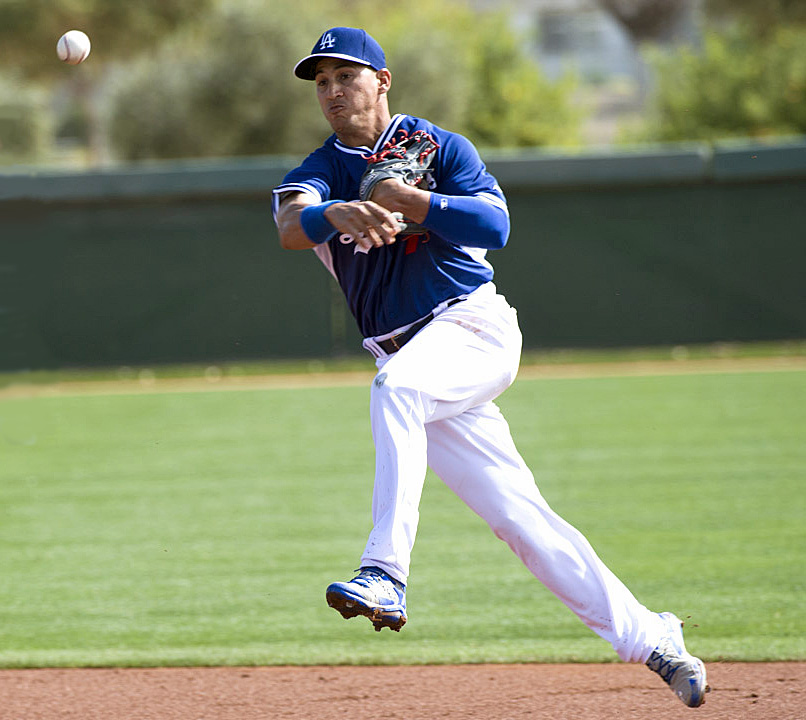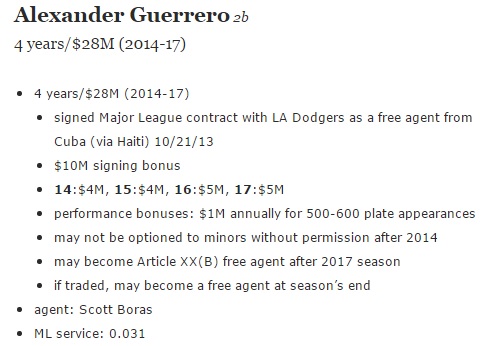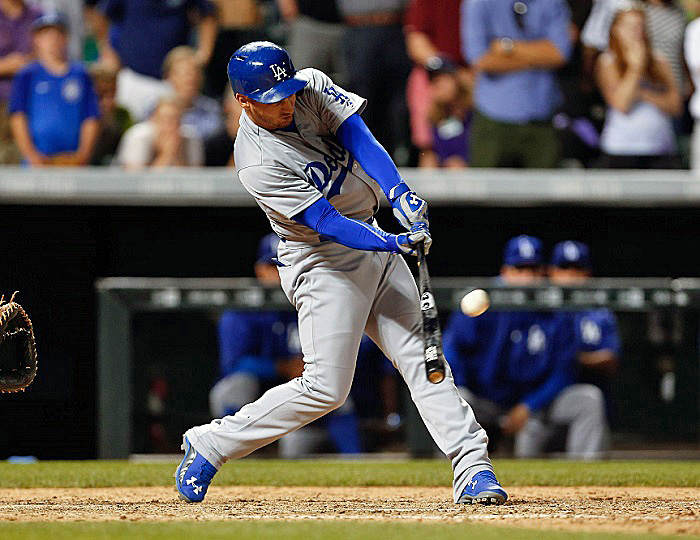At the time it seemed like a great idea; a bargain at the price – especially with the extremely deep pockets of Dodgers new ownership.
The date was October 23, 2013 and (then) Dodgers general manager Ned Colletti convinced Dodgers President and CEO Stan Kasten to roll the dice on a 26-year-old Cuban defector named Alexander (Alex) Guerrero, a shortstop who was considered among the best players in Cuba before defecting to Haiti in late 2013.
Although Guerrero was not considered a great defensive player, he was considered a very good hitter. In Fact, while being showcased in front of scouts from several MLB teams in the Dominican Republic, Baseball America’s Ben Badler wrote this about Guerrero:
Guerrero’s best tool is his right-handed power … Guerrero takes an uppercut stroke and he loses his balance against breaking pitches. It’s a pull-oriented, swing-for-the-fences approach that scouts think he will have to change to hit quality pitching.
Since arriving in the Dominican Republic, Guerrero has shown improved speed with above-average times in the 60-yard dash, which is highly unusual for a 26-year-old to start running faster … [Some] scouts think he can stay in the middle of the infield, although shortstop is probably out of the question. His hands and actions are playable but he doesn’t have the first-step quickness or range to play shortstop and he can be a bit stiff in the field. Second base could be an option for him and a team that likes him a lot will probably play him there.

The Dodgers tried desperately to convert Guerrero from a shortstop into a second baseman during spring training 2014. The experiment failed miserably. (Photo credit – Jon SooHoo)
Despite having never played in the MLB (or in the MiLB for that matter), the Dodgers signed Guerrero to a four-year / $28 million contract that included a $10 million signing bonus. As we’ve come to expect, Guerrero’s agent – baseball’s Antichrist Scott Boras – included a rather unique clause that said that Guerrero could not be optioned back to the minor leagues without his permission after 2014. It also said that if Guerrero were traded, he would immediately become a free agent at the end of that season in which he was traded. (Did I mention that Scott Boras is baseball’s Antichrist?).

From Guerrero’s standpoint, his Scott Boras-crafted contract was brilliant. From the Dodgers standpoint, not so much. (Courtesy of BaseballProspectus.com)
Although Colletti nor anyone else in the Dodgers organization would admit it at the time, one of the main reasons they signed Guerrero was because of their glaring need at second base. They had recently declined to re-sign (then) 36-year-old veteran Mark Ellis primarily because they sincerely believed that Guerrero would become their everyday second baseman going forward. In fact, Colletti even said as much during a January 8, 2014 press conference at Dodger Stadium.
“We still have questions at second base,” said Colletti. “If you’re going to put who’s leading the pack today, Alexander [Guerrero] is that player.”
During spring training 2014, Guerrero worked out almost exclusively at second base. It did end well. Instead of becoming Mark Ellis’ heir apparent at second base, Guerrero struggled at the position and also at the plate, which landed him at Triple-A Albuquerque after the two season-opening games in Sydney, Australia. Fortunately for the Dodgers, converted shortstop Dee Gordon did do well at the position and went on to earn a trip to the 2014 All-Star game – an accomplishment that he would repeat in 2015 as a member of the Miami Marlins.
After a rather troublesome season at Triple-A during which he had a portion of his left ear bitten off by catcher Miguel Olivo, Guerrero received a September 1, 2014 call-up to the Dodgers. It did not end well. In his 13 plate appearances, Guerrero had only one hit (a single) while striking out six times.
Knowing that Guerrero could not be sent back down to the minors, the now 28-year-old saw a considerable amount of playing time during spring training 2015 – primarily at third base and in left field. It did go well. So well, in fact, that the Dodgers were seriously considering making Guerrero their everyday third baseman except for one rather big reason – he was nowhere near as good of a defensive third baseman as 36-year-old Juan Uribe. However, Guerrero appeared to be living up to the hype of being a good hitter, going 15 for 49 (.304) with three home runs and eight RBIs in the 26 spring training games in which he played – 13 at third base, five in left field, four at shortstop and four as a DH/pinch-hitter.
With Scott Boras’ gun to their head, the Dodgers had no choice but to include Guerrero on their Opening Day roster which, for a while, appeared to be the greatest thing since sliced bread. In his first 22 at bats, Guerrero hit a remarkable five home runs – including two as a pinch-hitter. But without question, his single greatest contribution to the team was his dramatic, top of the ninth inning grand slam on June 2 against the Colorado Rockies in the second game of a doubleheader at Coors Field that turned an 8-5 deficit into a 9-8 Dodgers win to salvage a split in the twin bill.

Alex Guerrero’s dramatic game-winning, pinch-hit grand slam home run against the Rockies on June 2 was arguably the greatest moment of the season for the Dodgers.
(Photo credit – Isaiah J. Downing – Click on photo to view video)
Unfortunately, Guerrero began a steady decline offensively after his heroic grand slam and finished the regular season with a slash-line of .233 / .261 / .434 for a rather pedestrian OPS of .695. He appeared in a total of 106 games with 230 plate appearances in which he hit 15 home runs and drove in 36 runs with 57 strikeouts and seven walks. All of a sudden that $28 million wasn’t such a great deal after all. In fact, Guerrero finished his first full regular season so badly that he wasn’t even included on the Dodgers postseason roster.
The big question is: What do the Dodgers do with Alex Guerrero now? He is still owed $5 million for each of the next two seasons and that “if traded, may become a free agent at season’s end” clause makes him virtually untradable.
With Justin Turner the Dodgers likely third baseman, Corey Seager the likely shortstop, Jose Peraza and/or Howie Kendrick the likely second baseman; and with Carl Crawford and/or Scott Schebler the likely left fielder, Joc Pederson and/or Kiké Hernandez the likely centerfielder and Yasiel Puig the likely right fielder (not to mention Andre Ethier and back-up outfielders Scott Van Slyke and [probably] Justin Ruggiano), there is simply no place to put Alex Guerrero. As such, the Dodgers will more than likely dump another $10 million into their dead-money black hole and designate Guerrero for assignment after spring training 2016




 October 21st, 2015 at 9:25 am
October 21st, 2015 at 9:25 am  by Ron Cervenka
by Ron Cervenka  Posted in
Posted in 

It’s amazing how it’s hard to predict what the future of a player will be like. I also would like to point out that I think Ethier should be mentioned right along side of Puig in right field, at least until Puig proves he can get back to what he’s shown in the past.